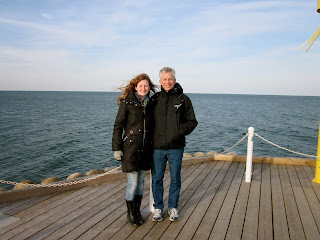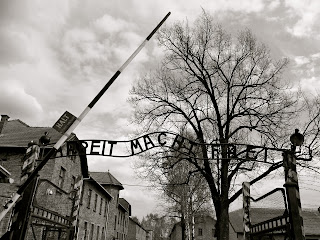10 Days with Bridget
From the Carpathians to the Baltic Sea, from the depravity
of Auschwitz in the south to the miracle of Solidarity in the north, Poland
provided amazing sights and rich history. For 10 days Bridget and I traveled
the country beginning and ending in Krakow, while visiting Warsaw, Gdansk, and
Sopot, with a side trip via overnight train to Prague in the Czech Republic.
Upon arriving in Krakow Bridget brought me to the Center for European Studies at Jagiellonian University where I met some of her professors and classmates, JU was established in 1364 or about 300 years before Europeans were steadily scrambling ashore in North America. We spent a transition day touring around Krakow
Upon arriving in Krakow Bridget brought me to the Center for European Studies at Jagiellonian University where I met some of her professors and classmates, JU was established in 1364 or about 300 years before Europeans were steadily scrambling ashore in North America. We spent a transition day touring around Krakow
and getting organized for a 6 day adventure to begin with the morning train to
Warsaw. Train travel in Europe is all it’s cracked up to be and this train was
clean, quiet and fast.

By the end of World War II Warsaw, Poland’s capitol and
largest city, was a smoking pile of rubble. 80% of the buildings were
destroyed. The Nazis deliberately set out to destroy the city as punishment for
two separate uprisings, first the Jewish Uprising in 1943 (Warsaw Jewish
Ghetto) and in 1944 the Warsaw Uprising. Our visit to the Uprising Museum was a
chilling lesson in that period of Warsaw’s history. Our visit to the Jewish
Ghetto and the monuments and memorials to the brave people imprisoned in that
ghetto was equally chilling and somber.
Warsaw was rebuilt under the Communist regime established by
the Soviet Union with cheap prefabricated housing and lack of imagination. Although
an effort was made to restore Warsaw’s historic Old Town to its former glory
and it is now a UNESCO World Heritage site.
We stayed at, gotta love this name, the Oki Doki Hostel our first night in town, located near the beautiful Royal Way and Old Town. We visited the University of Warsaw which has a lovely campus, drank molten chocolate at the E. Wedel’s flagship confectionary store, ceremoniously turned our backs on the former headquarters of the Communist government, toured 13th c. churches and sites in Old Town and New Town; Bridget even walked down a long flight of stairs that Napoleon Bonaparte once strolled.
After 2 days in Warsaw we headed for Gdansk on an early
morning bus. Polski Bus brought us in a clean, comfortable coach through
rolling farmland reminiscent of the American Midwest. Gdansk was another
ancient city, destroyed during WWII, this time largely by Allied bombs
liberating it from Nazi occupation. Impressive medieval fortifications
protected this city for hundreds of years; and we visited a church built in the
1300’s that can accommodate 25,000 worshippers. The highlight for me was
visiting the Gdansk Shipyards.
Solidarity was born here; Gdansk is where shipyard workers
fought for freedom from 45 years of Soviet occupation, and where Poland
contributed to the eventual downfall of the Soviet Union. I remember Lech
Walesa from the ’80’s and the stories of shipyard workers falling to Soviet
tanks in their battle for freedom. We stood where this struggle occurred –
Lenin Shipyard #2. We walked the grounds while I tried to imagine what it must
have been like.




 We lingered at the Monument to Shipyard Workers, in no hurry to leave. Near the Monument are sections
of the Berlin Wall and the Lenin Shipyard #2 Wall – prompting some reminiscing
about when I was in West Berlin in 1988 standing at the actual Berlin Wall
looking into East Berlin stunned by how drab and lifeless the city controlled
by the Soviet Union appeared.
We lingered at the Monument to Shipyard Workers, in no hurry to leave. Near the Monument are sections
of the Berlin Wall and the Lenin Shipyard #2 Wall – prompting some reminiscing
about when I was in West Berlin in 1988 standing at the actual Berlin Wall
looking into East Berlin stunned by how drab and lifeless the city controlled
by the Soviet Union appeared.
The next stop was Sopot, a seaside resort just a short train
ride away. A little early in the season to be at a seaside resort in Poland but
we both wanted to see the Baltic Sea – we did, it’s big.
Standing on the beach we looked back at a resort hotel, the same hotel at which Hitler stayed shortly after Germany started WWII by invading Poland from the Baltic Sea at nearby Westerplatte. Sopot had the feel of a seaside resort anywhere, we enjoyed strolling the Pier, had a delicious seafood dinner and a decadent desert of waffles topped with cream and fruit.
Standing on the beach we looked back at a resort hotel, the same hotel at which Hitler stayed shortly after Germany started WWII by invading Poland from the Baltic Sea at nearby Westerplatte. Sopot had the feel of a seaside resort anywhere, we enjoyed strolling the Pier, had a delicious seafood dinner and a decadent desert of waffles topped with cream and fruit.

After 2 days we flew from Gdansk back to Krakow in time to
take a tour of the famous Wieliczka Salt Mine. This mine has been producing
rock salt and has been operated by the same company for 700 years. As
unbelievable as it may seem everything in the picture is salt – the walls, the
floor, the stairway/banister/railing, the carvings, the chandeliers – at this
point we’re about 300 feet below ground. It was a fascinating tour and a
must-do for visitors to Krakow. And yes, if you lick the walls it tastes like
salt.
After flying from Gdansk to Krakow and touring a 700 year
old salt mine, it was time for Bridget to pack me off on the overnight train to
Prague, Czech Republic. The overnight train was a hoot. I shared a cabin with
berths about the size of side-by-side bathtubs with a stranger who spoke no
English. The train departed Krakow at 10pm and there’s not a lot else to do
except sleep so pretty quickly that’s just what we did, made our beds, changed
into our jammies and went to sleep. At 7am we pulled into the train station in
Prague. Despite the coziness I’m a fan of overnight train travel – you have to
sleep somewhere and you wake up in an entirely different city.
In Prague I was on my own. Bridget had been in charge of the
guide books, making reservations, and generally choosing every time we had to decide
whether to go left or right as wandered around cities. I lingered a while in
the train station before venturing out, wishing she was with me. With tourist
map in hand I eventually set off with a plan – head for the old town square,
work my way through the Jewish Quarter to find the Old Synagogue (c.1270), over
the Vltava River to see the Prague Castle (first masonry dating to c.885), St.
Vitas Cathedral (c.1344) and Franz Kafka Museum; cross the Vltava again on the
Charles Bridge (c.1375), work my way back through Old Town, and eventually wander
back to the train station for another overnight train back to Krakow. Mission
accomplished.
The overnight train back to Krakow was plush. I had the
cabin to myself, there was a little sink in the cabin with water bottles, and
they served coffee at 7am. I slept well, woke up ready to go and magically back
in Krakow.
The plan for the day was tour Krakow’s sites, the Jewish
Ghetto and Schindler’s Factory. Bridget was in her element here – no tourist
map needed. She brought me to Wawel Castle (14th century) and Cathedral Basilica of Sts. Stanislaus and Wenceslaus on grounds where a
church has stood for 900 years.
You can’t walk around a former Jewish
Ghetto without wondering what would justify such treatment of people. The
Schindler Factory tour was interesting but I can’t help partially seeing
Schindler as a war-profiteer, made rich by the existence of Nazi Germany and
the brutal treatment of Jewish people. I was to learn the next day that a
Jewish Ghetto didn’t approach the madness of a concentration camp.
The next day we toured Auschwitz. Auschwitz-Birkenau was
awful – what happened there was depraved. I’ve seen movies, I’ve read books, I
know a bit about WWII history. None of that adequately prepared me for seeing
it. Initially I took pictures, I stopped – eventually I began to quietly cry as
we walked the camp, the housing blocks, the torture cells, and the killing
wall. My reaction wasn’t unique. We walked into the crematorium through the
same entrance that so many imprisoned, enslaved souls did 65 years ago. We
moved through a doorway from the crematorium to the ovens. Shortly after that
something inside me broke. I began weeping in Bridget’s arms. Thankfully she
was there; I needed her strength at that moment. We both know something
fundamental in our relationship changed at Auschwitz. Visiting
Auschwitz-Birkenau will change a person.
Bridget and I made it back to Krakow, had a late dinner, and walked the ancient cobblestone streets of Old Town talking quietly, looking for some balance. Ice cream seemed in order – it’s always been comfort food for us - we found Krakow’s E. Wedel store and dug in.
I was set to fly home in the morning. Saying good night and
good bye to Bridget was hard. We lingered talking, reminiscing. Of all the
places we went, of all the sites we saw, of all the experiences we had – simply
being with her was the best part. Our baby has become a strong young woman, a
strong young woman capable of taking care of her dad when she had to. I love
you Bride. Thank you for sharing your world with me for 10 days. Let’s do
it again sometime!














































